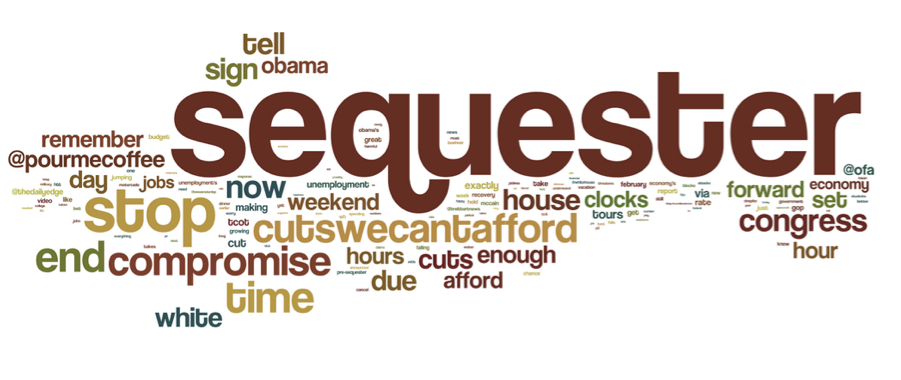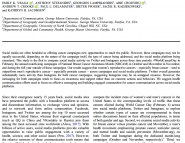se·ques·ter [si-kwes-ter] verb
- to remove or withdraw into solitude or retirement; seclude.
- to remove or separate.
- Law. to remove (property) temporarily from the possession of the owner; seize and hold, as the property and income of a debtor, until legal claims are satisfied.
- International Law. to requisition, hold, and control (enemy property).
Origin:
1350–1400; Middle English sequestren < Latin sequestrāre to put in hands of a trustee, derivative of sequester trustee, depositary
This wordcloud summarizes the sentiment of the Twitter community on the issue of sequestration:

Commentary on the topic by Mason Political Science professor Jennifer Victor (@jennifernvictor):
In summer of 2011 President Obama and the Congress were in a deadlock over budgeting, deficits, and debt. At the time, Republicans insisted on not raising the debt ceiling (the government’s legal borrowing limit) unless serious steps were taken to reduce the annual deficit. Republicans were interested in reducing spending and reforming entitlements, but Democrats were not willing to do any of those things without raising some taxes.
In August, President Obama and Congressional Republicans struck a deal (signed into law as the Budget Control Act of 2011). The deal went like this. First, appoint a bi-partisan committee to try to negotiate a deal to reduce the deficit. In order to give the committee a strong incentive to reach a compromise, include a “poison-pill,” a default result that is so distasteful for all involved that no one hopes the committee will fail. This reversion point, or default position, is the sequester. It is $1.2 trillion in spending cuts (alone) across the board, including sweeping military cuts (something Republicans historically have protected), to be phased in over 10 years.
The President appointed a bipartisan super committee in late-summer 2011, whose job it was to negotiate a deficit reduction deal. The super committee failed to reach an agreement in November of 2011 largely over the same impasse-causing positions the partisans held in the summer — the Republicans sought deficit reduction through only spending cuts, and the Democrats were unwilling to cut spending without raising taxes.
The dreaded sequester cuts were scheduled to kick in as of December 31, 2012 (and later extended to March 1, 2013). It was thought that over the course of the year, cooler heads would prevail and action would be taken to prevent the sequester cuts. However, December 2012 turned out to include numerous fiscal deadlines that proved to be too much for our legislative leaders to negotiate at once.
Also scheduled to expire on December 31, 2012 were the so-called Bush tax cuts,(reduced tax rates for everyone passed by Congress in 2001 and 2003 during the recession at that time), and the payroll tax cut (signed into law by President Obama during the most recent recession that reduced payroll taxes by 6% for most workers). These tax cuts were initially passed with “sunset” provisions that cause them to automatically expire. Of course, if a tax cut expires, it means a tax increase for anyone who benefited from the law. Also, the extension passed for unemployment benefits (another provision signed into law by President Obama during the most recent economic downturn), was also scheduled to expire.
The combination of the expiration of the Bush tax cuts, the payroll tax cut, the debt ceiling deadline, the expiration of unemployment benefits extension, AND the sequestration cuts became known as “the fiscal cliff.” In the deal that was reached to avert the cliff, the sequester deadline was pushed to March 1, 2012. Also in the deal, the debt ceiling was increased (no increases are necessary now until early summer 2013), and many of the Bush tax cuts were extended (except for those making more than $450,000). Unemployment benefits were not extended and the payroll tax cut expired.
Now that March 1, 2013 has passed without a deal, the government is scheduled to cut $1.2 trillion in spending over the next 10 years. About half of these cuts are to defense spending, about a third are to non-defense discretionary spending, and about 15 percent are to mandatory spending, which is primarily entitlements. The total reduction in spending for 2013 is $85.4 billion. The law states that cuts must be made evenly across programs, with some being exempt (such a Medicare provider payments).
Of course, now that the sequester is law, it is the new policy status quo. All future proposals to change policy (spending, taxation, or otherwise) will be measured against this new reality. Most parties except changes to be made, but of course, there is no agreement on how to go about doing it. As expected, Democrats seek to make future agreement subject to increasing revenues, while Republicans seek to make cuts in a more surgical (rather than blunt hatchet) manner.














